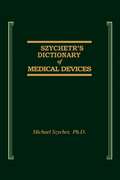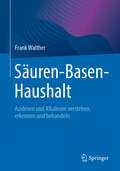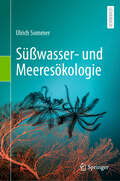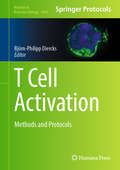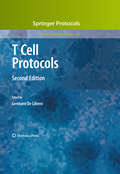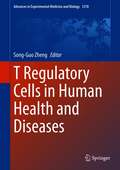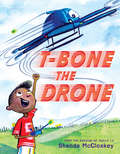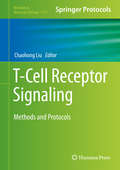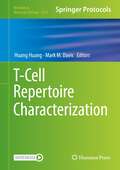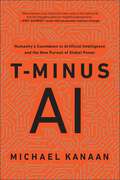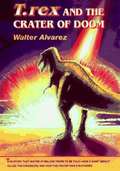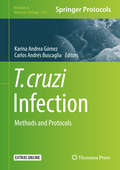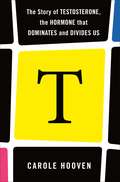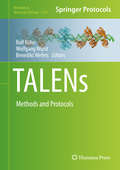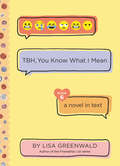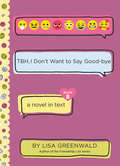- Table View
- List View
Szycher's Dictionary of Medical Devices
by Michael SzycherFROM THE PREFACEThe field of medical devices represents one of the most advanced technological areas in the United States. In 1991, over 12 million Americans had at least one medical device; fixation devices had the highest incidence, followed by contact lens use and lens implants and, lastly, artificial joints. The public has come to expect that medical devices will alleviate maladies and/or conditions that were not treatable fifty years ago. It is hard to believe that the first pacemaker was invented in the 1950s, the first artificial heart valve in 1952, and the first artificial hip replacement was performed in 1954. In 1992, the medical device industry exported a total of $6.9 billion, while the country imported a total of $3.9 billion, representing a $3.0 billion trade surplus. Medical devices are among the most regulated products in the world. The FDA maintains a constant vigil over medical device manufacturers and importers; even medical device definitions are subject to official scrutiny. Title 21 of the Code of Federal Regulations publishes these definitions, but the definitions are spread over several medical specialty areas and are, thus, difficult to find. This book attempts to bring a measure of order by providing an alphabetical listing of officially defined devices.
Szycher's Handbook of Polyurethanes
by Michael SzycherA practical handbook rather than merely a chemistry reference, Szycher's Handbook of Polyurethanes, Second Edition offers an easy-to-follow compilation of crucial new information on polyurethane technology, which is irreplaceable in a wide range of applications. This new edition of a bestseller is an invaluable reference for technologists, marketer
Szycher’s Practical Handbook of Entrepreneurship and Innovation
by Michael SzycherThis practical and comprehensive handbook offers step-by-step instruction, guiding entrepreneurs of innovative technology startups all the way from idea to profitability. With its easy-to-follow format aimed at both experienced as well as novice entrepreneurs, this book covers all technical, financial, legal, and governmental hurdles facing startups. It discusses common causes of business failure and points out the pitfalls to avoid in getting innovative technology successfully to market.
Säuren-Basen-Haushalt: Azidosen und Alkalosen verstehen, erkennen und behandeln
by Frank WaltherDieses Buch beinhaltet Grundlagen, Diagnostik und Therapie von Störungen des Säuren-Basen-Haushalts.Wer sich dafür interessiert, wie eine diabetische Ketoazidose entsteht, wie man sie behandelt, welchen Stellenwert die Therapie mit Puffersubstanzen bei Störungen des Säuren-Basen-Haushaltes hat, wie sich eine Hypothermie auf den Säuren-Basen-Haushalt auswirkt, was eine posthyperkapnische Alkalose ist, oder wer wissen möchte, wodurch sich BE- und Standardbikarbonat-Wert im Säuren-Basen-Status unterscheiden, findet die Erklärungen und Grundlagen dafür und noch etliches mehr in diesem Buch. Neben Kapiteln, die sich mit den weitgehend unveränderlichen Grundlagen und Grundsätzen der therapeutischen Möglichkeiten beschäftigen bzw. für Bereiche mit noch unzureichender Evidenzgrundlage die aktuell führenden Expertenmeinungen wiedergeben, werden zur Veranschaulichung 12 klinische Fälle präsentiert, an deren Beispiel die diagnostische Vorgehensweise bei unterschiedlichen Säuren-Basen-Störungen und die klinischen bzw. therapeutischen Schlussfolgerungen erläutert werden. Ziel des Buches ist die Vermittlung von fundiertem und doch praxisrelevanten, am Krankenbett einsetzbaren Wissen auf der Grundlage des Wissens aus der Biochemie und Physiologie-Ausbildung des Physikums. Es wendet sich an Ärztinnen und Ärzte verschiedener Facharztausbildungen sowie Medizinstudentinnen und -studenten.
Säuren-Basen-Haushalt: Azidosen und Alkalosen verstehen, erkennen und behandeln
by Frank WaltherDieses Buch beinhaltet Grundlagen, Diagnostik und Therapie von Störungen des Säuren-Basen-Haushalts. Wer sich dafür interessiert, wie eine diabetische Ketoazidose entsteht, wie man sie behandelt, welchen Stellenwert die Therapie mit Puffersubstanzen bei Störungen des Säuren-Basen-Haushaltes hat, wie sich eine Hypothermie auf den Säuren-Basen-Haushalt auswirkt, was eine posthyperkapnische Alkalose ist, oder wer wissen möchte, wodurch sich BE- und Standardbikarbonat-Wert im Säuren-Basen-Status unterscheiden, findet die Erklärungen und Grundlagen dafür und noch etliches mehr in diesem Buch. Neben Kapiteln, die sich mit den weitgehend unveränderlichen Grundlagen und Grundsätzen der therapeutischen Möglichkeiten beschäftigen bzw. für Bereiche mit noch unzureichender Evidenzgrundlage die aktuell führenden Expertenmeinungen wiedergeben, werden zur Veranschaulichung 12 klinische Fälle präsentiert, an deren Beispiel die diagnostische Vorgehensweise bei unterschiedlichen Säuren-Basen-Störungen und die klinischen bzw. therapeutischen Schlussfolgerungen erläutert werden. Ziel des Buches ist die Vermittlung von fundiertem und praxisrelevanten, am Krankenbett einsetzbaren Wissen auf der Grundlage des Wissens aus der Biochemie und Physiologie-Ausbildung des Physikums. Es wendet sich an Ärztinnen und Ärzte verschiedener Facharztausbildungen sowie Medizinstudentinnen und -studenten. In der 2. Auflage wurde das Buch sorgfältig überarbeitet und aktualisiert und um neue Informationen ergänzt, z. B. zum Kalzium-Phosphat-Haushalt und zur 2022 erschienenen neuen Leitlinie für die Behandlung der diabetischen Ketoazidose im Kindesalter.
Sífilis: otra enfermedad que nos llegó de Europa la medicina y la sífilis en el Viejo Mundo
by Naranjo PlutarcoEntre marzo y abril de 1495, en Nápoles, se desató una terrible epidemia de sífilis que luego se propagó a Francia y desde aquí al resto de Europa. Durante los primeros cuarenta años de la epidemia nadie puso en duda el sitio dónde se originó y luego cuál país se convirtió en el foco de diseminación del mal venéreo que comenzó a llamarse el morbo gálico. Inesperadamente ciertos autores poco escrupulosos, del siglo XVI, afirmaron que la sífilis era originaria de América, continente al cual, sin quererlo, Europa había "exportado" todas las pestes del Viejo Mundo. Existe un dicho popular: "favor con favor se paga", parafraseándolo en sentido inverso, parecería que se trataba de demostrar que hubo un intercambio epidémico y que en "reciprocidad" de las enfermedades que Europa envió a América, ésta exportó al Viejo Continente la sífilis.
Süßwasser- und Meeresökologie
by Ulrich SommerSüßwasser- und Meeresökologie bietet eine umfassende Einführung in die aquatische Ökologie, indem es die Fachgebiete Limnologie und biologische Ozeanographie integriert. Strukturiert wie allgemeine Ökologie-Lehrbücher, entwickelt es den Gegenstand von grundlegenden Einheiten wie Individuen bis hin zu komplexen Ökosystemen und globalen Biogeochemieprozessen. Das Buch hebt sich durch seine ausgewogene Auswahl an Beispielen aus Süßwasser- und Meeresstudien hervor, die Feldbeobachtungen, experimentelle Studien und Modelle umfassen. Es bietet nicht nur Einblicke in aktuelle Forschungsentwicklungen, sondern würdigt auch klassische Studien, die die theoretischen Grundlagen des Fachgebiets gelegt haben. Süßwasser- und Meeresökologie ist somit nicht nur ideal für grundlegende Kurse in biologischer Ozeanographie, Limnologie und Ökologie geeignet, sondern bietet auch fortgeschrittenen Studierenden, Lehrkräften und Wissenschaftlern mit unterschiedlichem Erfahrungshintergrund einen wertvollen Zugang zu den aquatischen Wissenschaften.
T Cell Activation: Methods and Protocols (Methods in Molecular Biology #2904)
by Björn-Philipp DiercksThis volume provides detailed, up-to-date methods used in basic and applied research on T-cell activation. Chapters explore the fundamentals in T-cell biology a board range cutting-edge techniques from initial Ca2+ live-cell imaging to downstream effector functions in autoimmune disease. Written in the format of the highly successful Methods in Molecular Biology series, each chapter includes an introduction to the topic, lists necessary materials and reagents, includes tips on troubleshooting and known pitfalls, and step-by-step, readily reproducible protocols. Authoritative and cutting-edge, T- cell activation: Methods and Protocols will be an indispensable protocol collection for researchers studying T-cell activation in inflammation and immunity.
T Cell Protocols
by Gennaro De LiberoWith a wide variety of investigative approaches, T cell immunology is a vital and open field of study. In T Cell Protocols, Second Edition, an international panel of experts contribute fully updated classic protocols as well as newly established novel techniques for the study of T lymphocyte biology. Written in the highly successful Methods in Molecular BiologyTM series format, the chapters in this volume provide brief introductions to the topics, lists of the necessary materials and reagents, step-by-step, readily reproducible laboratory protocols, and Notes sections which collect expert tips on troubleshooting and avoiding known pitfalls. Up-to-date and easy to use, T Cell Protocols, Second Edition is an ideal guide for young investigators new to the complex field of immunology as well as a valuable, concise resource for experienced scientists searching for clear, efficacious descriptions of novel methods.
T Regulatory Cells in Human Health and Diseases (Advances in Experimental Medicine and Biology #1278)
by Song-Guo ZhengThis book addresses one of the major challenges of immunology today that is being directed to the translation of the rapidly emerging volume of basic science contributions of immunology to clinical medicine. In so doing, the book systemically introduces and discusses concepts, classifications, phenotypic and functional descriptions of regulatory T (Treg) cells in health and disease. The authors of the 15 chapters were selected from among the most qualified experts in the field of Treg cell research who provide a comprehensive overview of Treg cells and their biology in the ensuing chapters.The beginning chapters provide a useful contemporary classification of Treg cell populations and then progress to chapters that explore basic mechanisms of Treg cell function and epigenetic control. In addition to descriptions of typical CD4+ Foxp3+ cells, other chapters provide detailed presentations of Treg subsets such as CD8+ Tregs and IL-10-producing Tr1 cells. The differences of various Treg subsets, as well as circulating and resident Treg cell populations, are next compared. Importantly, the next chapters provide the clinical correlation of Treg cells with autoimmune diseases, inflammatory diseases, metabolic diseases, cancer and organ transplantation and progress to chapters that highlight emerging innovative technology including nanoparticle-Treg cells and their translational values. In summary, the book will provide a valuable resource not only for graduate students and researchers in the fields of immunology, cell biology and translational medicine but also for all others interested in learning more about Treg cells and their application in human health and disease.
T-34 in Action: Soviet Tank Troops In World War Ii (Stackpole Military History Ser.)
by Artem Drabkin Oleg SheremetFirst-hand accounts from the Russian veterans of World War II who fought in the celebrated tanks that powered the Soviet armored forces. The Soviet T-34 medium tank was one of the most famous and effective fighting vehicles of the Second World War. Along with the German Tiger and the American Sherman, it was a milestone in tank design that changed the course of the conflict. Much has been written about the technical history of the tank and the vital part it played in the huge tank battles on the Eastern Front, but less has been said about the men who went to war in the T-34 and lived, fought and sometimes died in these remarkable machines. This pioneering book, which is based on extensive interviews with tank crews, records their experiences and offers a compelling inside view of armored warfare in the mid-twentieth century. &“An engaging book, and you will find yourself feeling the discomfort, anxiety, fear, pride and joy of a Soviet Tanker in WWII as you read the T-34 in Action.&”—Military Trader &“An excellent read and a good book for tank enthusiasts.&”—The Armourer
T-54 and T-55 Main Battle Tanks, 1944-2004
by Steven J. ZalogaThe T-54 and T-55 tanks are the most widely manufactured tanks of all time. They have become ubiquitous to wars around the globe since the 1950s, starting with Hungary in 1956, and including the the Arab-Israeli wars of 1967, 1973 and 1982, the Vietnam war of 1967-75, the Iran-Iraq War of 1980-88, the Afghanistan conflict, Operation Desert Storm, the Yugoslav Civil Wars, and the recent conflict in Iraq. This book will examine the roots of this prolific tank family, starting with the Soviet Army's first attempts to replace the legendary T-34 during World War II, and covering the T-43 and the T-44, the more successful T-54, and its ultimate evolution into the T-55.
T-Bone the Drone
by Shanda McCloskeyA new tech toy brings epic trials and triumphs in this playtime adventure for fans of The Most Magnificent Thing and Iggy Peck, Architect.Lucas has a new best friend when he bring T-Bone the Drone home from the store. They enjoy playing, flying, and even recharging together--but Lucas has been spending so much time with his new toy that he's on the sidelines when he tries to join the neighborhood Wiffle ball game. When the ball sails over the fence where a scary dog lives, it's the perfect opportunity for Lucas and T-Bone to do what friends do best: work together! It turns out that they'll need help from the whole team, though, to save the day...Finding the solution takes a little ingenuity and a lot of teamwork in this companion story to Doll-E 1.0 celebrating the inventive spirit of modern play.
T-Cell Motility: Methods and Protocols (Methods in Molecular Biology #1930)
by Navin Kumar VermaThis volume discusses the latest developments in cellular, molecular, biochemical, and imaging assays to study the biology and functions of T-cells. The chapters in this book cover topics such as LFA-1/ICAM-1 interactions in T-cell motility; using 3D-SIM to dissect signaling cross-talks in motile T-cells; GapmeR-mediated gene silencing in motile T-cells; activity of cellular kinases in migrating T-cells; and computational analysis of protein-protein interactions in motile T-cells. Written in the highly successful Methods in Molecular Biology series format, chapters include introductions to their respective topics, lists of the necessary materials and reagents, step-by-step, readily reproducible laboratory protocols, and tips on troubleshooting and avoiding known pitfalls.Cutting-edge and comprehensive, T-Cell Motility: Methods and Protocols is an essential resource for graduate students, postdoctoral fellows, and principal investigators working in the fields of immunology, T-cell biology, biochemistry, molecular biology, and imaging.
T-Cell Receptor Signaling: Methods and Protocols (Methods in Molecular Biology #2111)
by Chaohong LiuThis volume provides current and new advanced methods and protocols to study T cells. Chapters guide readers through T cell diversity using mass cytometry, analyzing T cells from single cell level, CRISPR/Cas9 techniques to study the T cell activation, techniques to study subsets of Tcell’s, procedures to study artificial antigen presentosomes for T cell activation, techniques to study the T cell development, two-photon microscopy, and MAIT cells. Written in the highly successful Methods in Molecular Biology series format, chapters include introductions to their respective topics, lists of the necessary materials and reagents, step-by-step, readily reproducible laboratory protocols, and tips on troubleshooting and avoiding known pitfalls. Authoritative and cutting-edge, T-Cell Receptor Signaling: Methods and Protocols aims to provide a wide range of approaches and be an invaluable resource for present and future generations of T cell researchers.
T-Cell Repertoire Characterization (Methods in Molecular Biology #2574)
by Mark M. Davis Huang HuangThis volume provides a comprehensive compilation of protocols in T cell repertoire analysis, from the leading experts in the field, representing both well-established methods and cutting-edge advances. Chapters broadly cover the emerging new T cell subsets, sequencing technologies for capturing TCR repertoire, and computational tools for analyzing an ever-growing TCR repertoire, with a particular focus on how to link the sequence with TCR antigen specificity. Written in the successful Methods in Molecular Biology series format, chapters include introductions to their respective topics, lists of the necessary materials and reagents, step-by-step, readily reproducible protocols, and notes on troubleshooting and avoiding known pitfalls. Authoritative and cutting-edge, T-Cell Repertoire Characterization aims to be a useful practical guide to researches to help further their study in this field.
T-Minus AI: Humanity's Countdown to Artificial Intelligence and the New Pursuit of Global Power
by Michael KanaanLate in 2017, the global significance of the conversation about artificial intelligence (AI) changed forever. China put the world on alert when it released a plan to dominate all aspects of AI across the planet. Only weeks later, Vladimir Putin raised a Russian red flag in response by declaring AI the future for all humankind, and proclaiming that, "Whoever becomes the leader in this sphere will become the ruler of the world." The race was on. Consistent with their unique national agendas, countries throughout the world began plotting their paths and hurrying their pace. Now, not long after, the race has become a sprint. Despite everything at stake, to most of us AI remains shrouded by a cloud of mystery and misunderstanding. Hidden behind complicated and technical jargon and confused by fantastical depictions of science fiction, the modern realities of AI and its profound implications are hard to decipher, but crucial to recognize. In T-Minus AI: Humanity's Countdown to Artificial Intelligence and the New Pursuit of Global Power, author Michael Kanaan explains AI from a human-oriented perspective we can all finally understand. A recognized national expert and the U.S. Air Force's first Chairperson for Artificial Intelligence, Kanaan weaves a compelling new view on our history of innovation and technology to masterfully explain what each of us should know about modern computing, AI, and machine learning. Kanaan also dives into the global implications of AI by illuminating the cultural and national vulnerabilities already exposed and the pressing issues now squarely on the table. AI has already become China's all-purpose tool to impose its authoritarian influence around the world. Russia, playing catch up, is weaponizing AI through its military systems and now infamous, aggressive efforts to disrupt democracy by whatever disinformation means possible. America and like-minded nations are awakening to these new realities—and the paths they're electing to follow echo loudly the political foundations and, in most cases, the moral imperatives upon which they were formed. As we march toward a future far different than ever imagined, T-Minus AI is fascinating and crucially well-timed. It leaves the fiction behind, paints the alarming implications of AI for what they actually are, and calls for unified action to protect fundamental human rights and dignities for all.
T. Rex and the Crater of Doom
by Walter AlvarezA geologist describes his research into the extinction of Tyrannosaurus rex and all dinosaurs, caused by a comet or asteroid hitting the Earth.
T. cruzi Infection: Methods and Protocols (Methods in Molecular Biology #1955)
by Karina Andrea Gómez Carlos Andrés BuscagliaThis volume provides detailed descriptions on cutting-edge experimental methods to assess the multiple and complex interactions between T. cruzi and its host. Chapters detail a series of methods and protocols, ranging from rather classical biochemical/genetic approaches to modern, powerful and high-throughput ‘-omics’ technologies, to tackle this issue, as well as novel techniques to improve treatment and clinical evaluation of Chagasic patients. Genome-wide mining strategies aimed at identifying potential parasite antigens and vaccine candidates and an overview on the challenges and milestones encountered during T. cruzi genome assembly are also included. Written in the highly successful Methods in Molecular Biology series format, chapters include introductions to their respective topics, lists of the necessary materials and reagents, step-by-step, readily reproducible laboratory protocols, and tips on troubleshooting and avoiding known pitfalls.Authoritative and cutting-edge, T. cruzi Infection: Methods and Protocols aims to provide students, researchers, and clinicians who are interested in the study of Chagas disease an indispensable source of information.
T: The Story of Testosterone, the Hormone that Dominates and Divides Us
by Carole HoovenThrough riveting personal stories and the latest research, Harvard evolutionary biologist Carole Hooven shows how testosterone drives the behavior of the sexes apart and how understanding the science behind this hormone is empowering for all.Since antiquity—from the eunuchs in the royal courts of ancient China to the booming market for “elixirs of youth” in nineteenth-century Europe—humans have understood that typically masculine behavior depends on testicles, the main source of testosterone in males. Which sex has the highest rates of physical violence, hunger for status, and desire for a high number of sex partners? Just follow the testosterone.Although we humans can study and reflect on our own behavior, we are also animals, the products of millions of years of evolution. Fascinating research on creatures from chimpanzees to spiny lizards shows how high testosterone helps males out-reproduce their competitors. And men are no exception.While most people agree that sex differences in human behavior exist, they disagree about the reasons. But the science is clear: testosterone is a potent force in human society, driving the bodies and behavior of the sexes apart. But, as Hooven shows in T, it does so in concert with genes and culture to produce a vast variety of male and female behavior. And, crucially, the fact that many sex differences are grounded in biology provides no support for restrictive gender norms or patriarchal values. In understanding testosterone, we better understand ourselves and one another—and how we might build a fairer, safer society.
TALENs
by Ralf Kühn Wolfgang Wurst Benedikt WefersThis volume provides a comprehensive collection of protocols on new technology across various model organisms. Chapters describe species-specific methods to generate new mutants the content is completed by chapters on natural TAL effectors, TAL element DNA binding principles, TALEN target site prediction, and methods for the efficient construction of TALEN coding regions. While addition chapter focus on the application of TALEN as sequence-specific nucleases and TAL based gene activators or inhibitors and the visualization of chromatin dynamics in live cells. Written in the highly successful Methods in Molecular Biology series format, chapters include introductions to their respective topics, lists of the necessary materials and reagents, step-by-step, readily reproducible laboratory protocols, and tips on troubleshooting and avoiding known pitfalls. Authoritative and cutting-edge, TALENs: Methods and Protocols aims to ensure successful results in the further study of this vital field.
TBH #5: TBH, I Feel the Same (TBH #5)
by Lisa GreenwaldThree BFFs try to make new friends but keep the old in the fifth book in Lisa Greenwald’s hilarious series told entirely in text messages, emojis, and notes. Perfect for fans of Invisible Emmie and the Dork Diaries books.Making new friends is a good thing, right? Not when you barely see your besties! Between swim team, the school play, and poetry club, BFFs Cece, Gabby, and Prianka are meeting different people and trying different things. But besties clash when Gabby’s new friends rank the other girls in their grade in categories like looks, smarts, and popularity.The question is: How can you be your best self if your BFFs don’t have your back?
TBH #6: TBH, You Know What I Mean (TBH #6)
by Lisa GreenwaldThree BFFs prove that girls can do anything they set their minds to in the sixth book in this hilarious series told entirely in text messages, emojis, and passed notes. Perfect for fans of Invisible Emmie and the Dork Diaries. TBH, sometimes boys say dumb things about girls. And Cece is sick of it!When she leads a super-successful event at school to raise awareness, everyone starts looking to her to take charge—of everything. Prianka needs ideas for National Poetry Month, Victoria wants advice on volunteer projects, and Gabby needs homework help. To be honest, being a leader is fun but the pressure is OOC (out of control)! Can Cece help her friends without totally losing it herself?
TBH #7: TBH, No One Can EVER Know (TBH #7)
by Lisa GreenwaldWith a Valentine’s Day dance, snooping parents, and way too many secrets, these four BFFs have a lot to deal with in the seventh book in this hilarious series told entirely in text messages, emojis, and passed notes, perfect for fans of Invisible Emmie and the Dork Diaries series. It’s no secret that Victoria’s mom can be OTT overprotective! But lately her anxiety has been too much to handle. So even though Victoria is helping plan the school’s Valentine’s Day dance, she might not be allowed to go!To be honest, she’s going to need lots of help from her BFFs to mend this mother-daughter relationship—and it may mean sharing her most embarrassing secret ever! The question is: Can you take back a secret once you’ve shared it?
TBH #8: TBH, I Don't Want to Say Good-bye (TBH #8)
by Lisa GreenwaldWhen summer break brings BIG changes, these BFFs 4EVA may end up saying good-bye 4EVA in the eighth and final book in this popular middle-grade series told entirely in text messages, emojis, and passed notes. Perfect for fans of Invisible Emmie and the Dork Diaries. TBH, Cece, Prianka, and Gabby thought they’d be together forever. But when Gabby’s mom announces she’s moving to Texas and a backyard BBQ party gets the friends’ blow-out summer off to a rocky start, they end up spending more time apart than together! To be honest, Gabby just wants to get the good-byes over with already. The question is: How can they be BFF 4EVA if everyone goes their separate ways?
